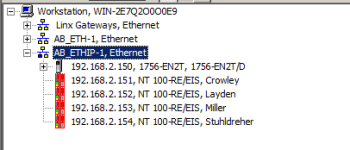That reminds me of the time I set such an Attribute in a bunch of flow meters in an Effluent Plant to the 4 Beatles 1st names: John, Paul, George and Ringo and parts of their Song Titles - Taxman, Walrus, Helter, Strawberry, Help! The Project Engineer wasn't to enamored when he saw them listed on my laptop. So the next day I told him I had them changed. He came to have a look and I now had them all changed to Rolling Stones references. He could not see the funny side. What a stiff!
As you know, under the DeviceNet specification, CIP devices are required to provide an Identity Object. Within that Identity Object there are Mandatory Instance Attributes and Optional Instance Attributes...
Optional Identity Object Instance Attributes -
- State
- Configuration Consistency Value
- Heartbeat Interval
- Active Language
- Supported Language List
- International Product Name
- Semaphore
-
Assigned_Name
- Assigned_Description
- Geographic_Location
- Modbus Identity Info
- Protection Mode
The 3 Optional Attributes highlighted are intended to be editable by the End User so as to identify the device within an application. It would normally be one of these Optional Attributes they would have provided and that you are editing for those names.
Mandatory Identity Object Instance Attributes -
-
Vendor ID
-
Device Type
-
Product Code
- Revision
- Status
- Serial Number
- Product Name
In particular, the Attributes highlighted are assigned by the ODVA/Vendor to clearly distinguish and identify the Vendor and product type to the End User. These Attributes are (should?) not normally be editable by the End User.
Ken Roach said:
...the Hilscher NT100 network gateways give you full control over the values that are used for the EtherNet/IP CIP Identity Object...
Are you saying though that they are all editable on this particular device, Ken?
The CIP specification only states which Attributes must be included in the Identity Object and which may be optionally included. It does not, however, specify how the Object data is actually implemented. But I would have thought it prudent for any Vendor to not make such Vendor specific Attributes editable by the End User? I would have thought in particular that the ODVA would not take too kindly to End Users changing a device's Vendor ID; something they try to control quite tightly, as you know.
Of course we can all "play around" with EDS files as well, but many don't even go there, I'm sure.
Regards,
George





